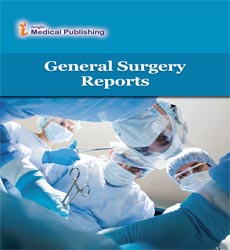Understanding Uterine Fibroids: Causes, Symptoms and Impact on Women's Health
Johan Ward*
Department of Surgery, Johns Hopkins University School of Medicine, Baltimore, Maryland
- *Corresponding Author:
- Johan Ward
Department of Surgery, Johns Hopkins University School of Medicine, Baltimore,
Maryland,
E-mail: alvaro@gmail.com
Received date: May 21, 2024, Manuscript No. IPGSR-24-19072; Editor assigned date: May 23, 2024, PreQC No. IPGSR-24-19072 (PQ); Reviewed date: June 06, 2024, QC No. IPGSR-24-19072; Revised date: June 13, 2024, Manuscript No. IPGSR-24-19072 (R); Published date: June 20, 2024, DOI: 10.36648/2393-8854.11.2.167
Citation: Ward J (2024) Understanding Uterine Fibroids: Causes, Symptoms and Impact on Women's Health. Gen Surg Rep 11.2: 167.
Description
Uterine fibroids, also known as leiomyoma’s or mimosa, are noncancerous growths that develop within the muscular wall of the uterus. These growths are common, affecting up to 70%-80% of women by the age of 50. Despite their prevalence, the exact cause of uterine fibroids remains unknown, although a combination of genetic, hormonal and environmental factors is believed to play a role. Understanding the causes, symptoms and impact of uterine fibroids on women's health is important for effective diagnosis, management and treatment. The development of uterine fibroids is influenced by several factors. Genetics play a significant role, as women with a family history of fibroids are more likely to develop them. Hormones, particularly estrogen and progesterone, also contribute to fibroid growth. These hormones promote the proliferation of the uterine lining during the menstrual cycle and can similarly stimulate fibroid growth. Additionally, fibroids tend to shrink after menopause, further indicating their hormonedependence. Other risk factors include early onset of menstruation, obesity, vitamin D deficiency and dietary habits high in red meat and low in green vegetables, fruit and dairy.
Pelvic pain
The symptoms of uterine fibroids vary widely depending on their size, number, and location within the uterus. Many women with fibroids are asymptomatic and may only discover them during a routine pelvic exam or prenatal ultrasound. However, symptomatic fibroids can cause a range of issues. The most common symptoms include heavy menstrual bleeding, prolonged periods, and pelvic pain or pressure. Women may also experience frequent urination, difficulty emptying the bladder, constipation and back or leg pain. In severe cases, heavy bleeding can lead to anemia, characterized by fatigue and weakness.
The presence of fibroids can significantly impact a woman's quality of life and overall health. Heavy menstrual bleeding and prolonged periods can interfere with daily activities and lead to chronic fatigue due to anemia. Pelvic pain and pressure can cause discomfort and pain during intercourse, negatively affecting intimate relationships. Additionally, fibroids can complicate pregnancy by increasing the risk of miscarriage, preterm birth and complications during labor. Some women with fibroids may also experience infertility or difficulty conceiving, adding emotional and psychological stress to their physical symptoms. Diagnosing uterine fibroids typically involves a combination of medical history, physical examination, and imaging studies. During a pelvic exam, a healthcare provider may feel irregularities in the shape of the uterus, suggesting the presence of fibroids. Ultrasound, both transabdominal and transvaginal, is commonly used to confirm the diagnosis and determine the size and location of the fibroids. In some cases, additional imaging tests such as Magnetic Resonance Imaging (MRI), hysterosonography, or hysteroscopy may be necessary to provide more detailed information.
Uterine fibroids
Management and treatment of uterine fibroids depend on the severity of symptoms, the size and location of the fibroids, the woman's age and her desire to have children. For asymptomatic fibroids or those causing mild symptoms, a watchful waiting approach may be recommended, with regular monitoring to assess fibroid growth. Medications can help manage symptoms, particularly heavy menstrual bleeding and pain. Hormonal treatments, such as Gonadotropin-Releasing Hormone (GnRH) agonists, can shrink fibroids temporarily by reducing estrogen and progesterone levels. Nonsteroidal Anti-Inflammatory Drugs (NSAIDs) and oral contraceptives may also be prescribed to manage pain and bleeding. For women with moderate to severe symptoms, surgical options may be considered. Myomectomy, the surgical removal of fibroids, is an option for women who wish to preserve their fertility. Hysterectomy, the removal of the uterus, is a definitive treatment for fibroids and may be recommended for women who have completed their families or when other treatments have failed. Minimally invasive procedures, such as Uterine Artery Embolization (UAE) and Magnetic Resonance-Guided Focused Ultrasound (MRgFUS), offer alternative options for reducing fibroid size and alleviating symptoms without major surgery. In conclusion, uterine fibroids are a common condition that can significantly impact women's health and quality of life. Understanding the causes, symptoms and treatment options for fibroids is essential for effective management and improving patient outcomes. Continued research and advances in medical treatment offer hope for less invasive and more effective therapies, providing relief and improving the quality of life for women affected by this condition.
Open Access Journals
- Aquaculture & Veterinary Science
- Chemistry & Chemical Sciences
- Clinical Sciences
- Engineering
- General Science
- Genetics & Molecular Biology
- Health Care & Nursing
- Immunology & Microbiology
- Materials Science
- Mathematics & Physics
- Medical Sciences
- Neurology & Psychiatry
- Oncology & Cancer Science
- Pharmaceutical Sciences
